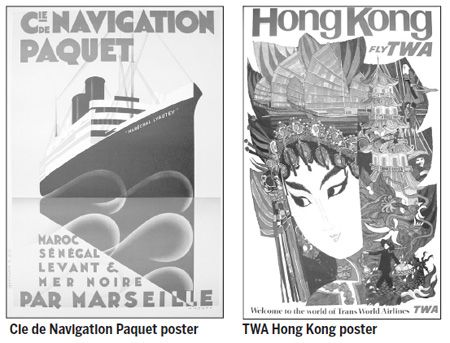Vintage posters in a market of their own for buyers
Updated: 2011-01-07 06:40
(HK Edition)
|
|||||||||

If you think of picture posters simply as wall decorations for teenagers and students, think again. Posters are also highly collectable objects - something very much for grown-ups with money to spend. But forget the images of contemporary pop singers and sports stars - if you want to build up a valuable collection you are advised to look to the past.
It all began in Paris in the 1870s following the development of lithographic printing. Among those attracted by the ability to print on larger sheets of paper was artist Jules Cheret. His colorful, thoroughly modern posters for theaters, including the Moulin Rouge, and later for a wide range of consumer products, attracted a great deal of attention. Posters really came into their own in the 1890s, when they were embraced by artists such as Henri de Toulouse-Lautrec and Alphonse Mucha.
Hong Kong's foremost vintage poster dealer is Picture This, run by Christopher Bailey. "Vintage means approximately anything at least 25 years old. I am interested in contemporary posters, too, though it comprises a small part of my business."
Posters produced for a purpose, that is to advertise an event, product or service, are more valuable than purely decorative ones. Rarity and condition are important factors when building up a collection, but not necessarily age.
"The date is not inherently important, but there is a link," says Bailey. Not all posters are attributed to an artist or designer, but names such as Cheret, Toulouse-Lautrec, Mucha, Cassandre and Andy Warhol will also have a bearing on value.
Cassandre created many notable Art Deco images in the 1930s, including ocean liners and the Dubonnet drinks posters, and his typography was very much an integral part of the design. Cassandre posters go for around $15,000-20,000 today. Toulouse-Lautrec posters tend to be priced around $20,000-500,000; while Mucha's Art Nouveau posters that are less concerned with the product sell for $10,000-40,000.
Major categories include entertainment, travel, products, and political messages. Entertainment covers a range of activities including theater, exhibitions and sporting events such as the Olympic Games, World Cup and Grand Prix motor racing - but most important of all are movie posters.
"Film posters are the most valuable because there is a lot of money in Hollywood," says Bailey. "Most sought after are those advertising movies from the 1930s and 40s, such as Casablanca, Citizen Kane and the classic horror genre; sci-fi B-movies from the 1950s are also popular. These posters can sell for $100,000 or even $500,000 at the top of the market."
One or two posters a year will sell for as much as $250,000-500,000. Heritage Auction Galleries of Dallas had a horror movie poster believed to be unique in its November sale estimated at $75,000 to $1 million, though it didn't sell. "If you can find posters from a 1930s movie that nobody else has heard of, you could pay as little as $100," Bailey adds.
Vintage travel posters focus mainly on destinations, airlines, railways and shipping lines. Those advertising resorts on the French Riviera are among the most sought after. Bailey says that collectors will pay between $5,000-12,000 for France, whereas Asian travel themes go for around $4,000. "The prices have been rising for Asia in the past few years, and they will catch up."
A good entry level price for collectable posters is around HK$8,000-10,000. The market in Hong Kong is small but growing.
"It is quite focused on the Far East and film posters," says Bailey. "Those who do buy film posters often have nostalgic reasons - they went to a particular movie on the first date with their wife - or because of interest in a particular actor or genre. Audrey Hepburn, James Bond and Star Wars movie posters sell well here. There's growing interest in the so-called Shanghai Cigarette girl posters that can be found around Cat Street, though one should beware of fakes."
Do vintage posters get put up on walls? Yes - but in a proper frame, not with students' sticky tape! "Actually, the big leap for collectors is when they shift from hanging the posters on the wall to storing them in a proper plan cabinet," says Bailey.
(HK Edition 01/07/2011 page2)